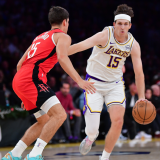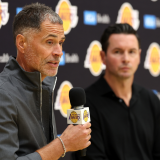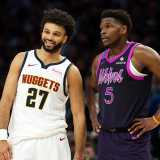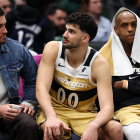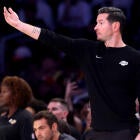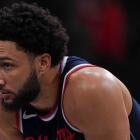
Lakers trade guide: Possible deals, in-season moves Rob Pelinka can make to boost LeBron's championship hopes
The Lakers have limited flexibility, but can still improve their team
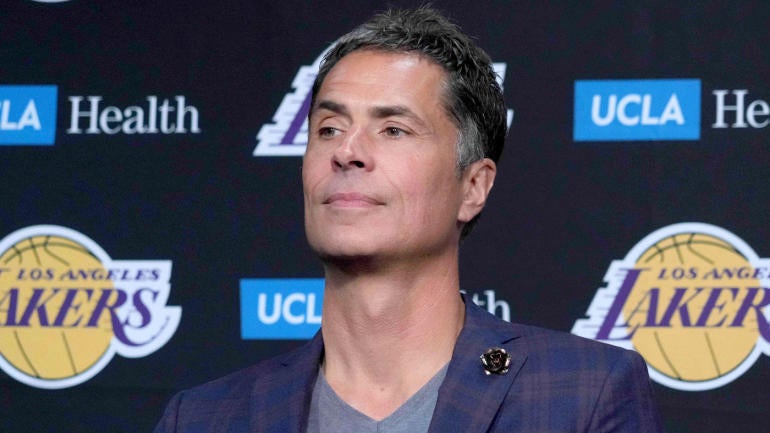
The all-in nature of most LeBron James teams often forces his front offices to make big swings at the trade deadline when the initial roster isn't working. It happened in 2008 when the Cleveland Cavaliers landed Wally Szczerbiak, Ben Wallace and Delonte West. It happened in 2015 when they nabbed Timofey Mozgov, JR Smith and Iman Shumpert. It happened in 2018 when they practically dealt the entire roster for one last run at a title with James. Patience is not a virtue he affords his GMs. That's especially true as he approaches his 37th birthday.
But the 2021-22 Los Angeles Lakers face far more difficult circumstances than any of those teams did. They cashed in most of their trade chips in the offseason when they landed Russell Westbrook. The bulk of their draft capital went to acquiring Anthony Davis in 2019. At 12-11 it would be hard not to be disappointed by the way the Lakers have started the season, but given the inevitable constraints that came with the way they built the team, there just aren't that many ways for them to improve like LeBron's previous rosters have.
That doesn't mean it's hopeless, though. It's going to take some creativity and luck, but there are still moves on the table for GM Rob Pelinka and this front office. Below is an in-depth guide to all of the possible trades, buyout additions and other moves the Lakers could potentially make between now and the postseason.
Important dates
Here is a brief list of the important roster-building dates the Lakers will face this season:
- Dec. 15, 2021: Ten of the 11 free agents the Lakers signed this offseason become eligible for trades. Those players are DeAndre Jordan, Rajon Rondo, Carmelo Anthony, Wayne Ellington, Trevor Ariza, Malik Monk, Kent Bazemore, Dwight Howard, Austin Reaves and Kendrick Nunn. The Lakers play their 29th game on this date.
- Dec. 17, 2021: Avery Bradley becomes eligible for a trade as 60 days have passed since he was claimed off waivers. The Lakers play their 30th game on this date.
- Jan. 7, 2022: Bradley's contract becomes guaranteed for the season. If he is waived before this point, the Lakers can get out of the rest of his deal. The Lakers play their 40th game on this date.
- Jan. 15, 2022: Talen Horton-Tucker becomes trade-eligible. His date is different from the other free agents the Lakers signed this offseason because he was a free agent with Bird Rights that is making more than the minimum and received a raise greater than 20 percent. The Lakers play their 43rd game on this date.
- Feb. 10, 2022: The NBA trade deadline arrives. The Lakers will have played 56 games by this date.
- March 1, 2022: Any buyout candidate who wishes to be eligible for the playoffs with a new team must be waived by his old team by this date. The Lakers play their 61st game on this date.
Needs
It should surprise no one to hear that a team that employs 10 minimum-salary players has a number of needs. Two of them stand out as critical for this team's championship hopes, while three more should be addressed if possible. We'll start with the most pressing concerns and work our way down.
Point of attack defense
To make it through the Western Conference, the Lakers will almost certainly have to beat either Stephen Curry or Devin Booker, if not both. Damian Lillard, Luka Doncic, Donovan Mitchell and Ja Morant may also stand in their way in the early rounds, and if they do reach the Finals, there's a good chance James Harden and perhaps Kyrie Irving will be waiting for them. This wouldn't have been a problem for the Alex Caruso-Kentavious Caldwell-Pope backcourt of yesteryear, but it's going to be the single-biggest obstacle to a 2022 championship for the Lakers.
The Lakers allow the fifth-most points (24.3) and the fourth-most assists (9.1) per game to opposing point guards in all of basketball, according to FanDuel. Basketball-Index categorizes five Lakers as primarily point-of-attack defenders: Horton-Tucker, Rondo, Bazemore, Ellington and Bradley, and most defensive metrics loathe the lot of them. All five have negative Defensive Box Plus-Minus ratings and FiveThirtyEight's Defensive RAPTOR only rates Bazemore as a positive.
The eye test tells a similar story. Horton-Tucker was supposed to be the Lakers' stopper this season, but he's still a novice when it comes to navigating screens. Bradley has fallen off a cliff since his stellar 2019-20 regular season, and even if he can pressure the ball, he's a virtually non-existent help-defender. Austin Reaves has shown some potential, but he simply isn't bulky enough to keep the best guards away from the basket.
There is some internal upside here. Maybe Horton-Tucker, who's played only 81 NBA games to date, grows as the season moves on. Maybe Bazemore, who was an offensive liability earlier in the season, can find his shot when he gets his next chance in the rotation. A younger LeBron was the ultimate trump card here, as Jamal Murray learned in 2020, and he might need to save them again late in games. But realistically, if the Lakers don't either acquire or manufacture better point-of-attack defense, they are not going to win the championship. The double-barreled rim protection that came with their bigger lineups of the past two seasons might have been able to overcome poor work on the perimeter, but with Davis as the lone rim protector, penetrating guards have completely punctured the Lakers defense this season. It's why they're allowing the second-most points in the paint per game (50) in the NBA this season.
Forward depth
If we assume that the Lakers are going to use Davis almost exclusively as a center in the postseason, that leaves only three forwards on the entire roster. All three of them -- James, Anthony and Ariza -- are 36 or older. History suggests that Anthony is going to get switch-hunted off the floor in the playoffs. Ariza hasn't even played this season. The Lakers are designed to play guard-heavy lineups, but not even James and Davis can be everywhere at once. Cumulative size is essential to help defense, and when teams start forcing bad switches, such small groups allow too much matchup vulnerability.
A multi-positional forward that can defend in the Kyle Kuzma mold would be extremely valuable on this roster. The problem is that such players are extremely valuable on every roster. That's why they're so hard to get, and it's why the Lakers, who largely wielded only the minimum in free agency, have so few of them. If the Lakers go big-game hunting at the deadline, this is probably the slot that they target.
A small-ball five not named LeBron
No lineup archetype has been more successful for the Lakers this season than LeBron at center. They've played 32 minutes in that alignment and won them by 19 points, but there are two reasons they can't afford to overuse it. The first is more of a regular-season concern. They don't want to wear James out. The second is more troubling in the postseason. One of the primary benefits of going so small is that it spaces the floor more for Russell Westbrook, but if Westbrook needs to be attached to James in bench lineups, that deprives Davis' bench groups of a primary ball-handler. The Lakers would probably prefer to either pair Westbrook with Davis when James rests or find him a different floor-spacing big so that James can support the bench lineups Davis plays in. If they settle on the latter, the James-Davis pick-and-roll should devastate opposing reserves. This would be an added benefit of making a major trade for a two-way forward. Acquiring someone who could play power forward with the starters and center off the bench would go a long way in solving these problems.
Shooting from a somewhat reliable defender
Carmelo Anthony, Malik Monk and Wayne Ellington are the only Lakers making even 35 percent of their 3-pointers on real volume this season. All three are going to get picked on defensively in the playoffs. Every team needs 3-and-D help, but the Lakers especially should be scouring the league for a competent defender that can make 3s, because right now, most of their wings can only do one or the other.
Auxiliary rebounding
The Lakers can't really prioritize rebounding with Davis at center, but their inability to pull in boards has killed them all year. They currently rank 21st in rebounding rate and dead-last in box-out rate, and that's severely limiting the transition opportunities they need to live on offensively with Westbrook on the floor. Again, with Davis at center, there isn't an obvious way to inject more rebounding into most Lakers lineups, but if they can find a guard or forward who does it well, that would be a nice bonus.
Tradable salary
The amount of salary a team can absorb in a trade typically depends on the overall scale of the deal, but matters are significantly simplified for the Lakers because they are paying the luxury tax. Any team above the tax line can absorb no more than 125 percent of the salary they send out in a trade, plus $100,000. If we operate under the assumption that James, Davis and Westbrook are not going to be traded, that leaves the Lakers with very little flexibility to make a significant deal because only two of their remaining 12 players make more than the minimum. Here is the functional matching salary that they currently have to work with:
- Talen Horton-Tucker makes $9,500,000.
- Kendrick Nunn makes $5,000,000.
- Nine of the 10 minimum-salary players on the team count for the same amount under the cap: $1,669,178. All nine of those players earn more actual cash, but a player's minimum salary depends on how much NBA experience he has, and since the league doesn't want teams shunning older players in favor of younger, cheaper ones, it reimburses teams for the difference between their actual salary and the minimum salary of a second-year player, which is the figure above. Therefore, for cap and tax purposes, that is what they cost.
- Austin Reaves is the lone exception in the minimum group. As an undrafted rookie, his cap figure is his actual salary, which is only $925,258.
Just to cover our bases, there is one unlikely way in which the Lakers could scrounge up a bit more tradable salary. When they traded Marc Gasol to Memphis during the offseason, they didn't receive any salary in return. They therefore created a trade exception worth his $2,692,991 salary which they can use to absorb any player making that much or less.
They would have to get rid of a player (likely by waiving the non-guaranteed Bradley) to clear a roster spot for this tactic to work, but more importantly, they would need to act quickly. While teams are free to deal players immediately after trading for them, they can only aggregate their salaries within multi-player trades if they wait 60 days after acquiring them. That means that if the Lakers are going to use this tactic to add a $2.7 million player for the purposes of eventually trading him, they'd have to do so no later than Dec. 11, 60 days before the deadline. That date is quickly approaching, so this option will soon be removed from the table.
Let's say that the Lakers don't use the Gasol exception in this way. Here is how much salary they can absorb if they deal out the following combinations of players:
| Lakers players | Zero minimums | One minimum | Two minimums | Three minimums | Four minimums |
|---|---|---|---|---|---|
Kendrick Nunn | $6,350,000 | $8,436,471 | $10,522,944 | $12,609,416 | $14,605,890 |
Talen Horton-Tucker | $11,975,000 | $14,061,472 | $16,147,945 | $18,234,417 | $20,320,890 |
Nunn and Horton-Tucker | $18,225,000 | $20,311,472 | $22,397,945 | $24,484,417 | $26,570,890 |
Neither Nunn nor Horton-Tucker | $0 | $2,186,472 | $4,272,945 | $6,359,417 | $8,445,890 |
Before you go concocting trades involving $26 million players, remember that roster size constraints make such deals extremely difficult. There's a reason five-for-one and six-for-one trades happen almost exclusively in the offseason: rosters can hold up to 20 players at that point. In-season, the limit is 15, and very few teams have fewer than that. Right now, there are only six open roster spots in the NBA: one each from the Jazz, Heat, Trail Blazers, Timberwolves, Raptors and Suns. Many of those teams left that slot open because of tax or hard cap constraints, and with four of them in the Western Conference, it's not a group that's going to be particularly eager to help the Lakers. To make an unbalanced trade, they're either going to have to entice the other team into waiving a few players at the back of their roster or pay off one of these teams to take someone in.
Finally, we have to acknowledge the real-world financial impact of a major trade. The Lakers let Alex Caruso go in large part because of the obscene tax bill retaining him would have generated. Those tax concerns haven't gone away. Right now, the Lakers are hovering around $202.5 million in salary plus tax payments, and because the tax gets more punitive the deeper in a team goes, a trade could get very pricey very quickly. Remember, if the Lakers do make an unbalanced trade, they'll have to sign new players to replace the ones they dealt just to get to the 14-player roster minimum. That's going to cost money as well. The point is that Pelinka is going to have to sell the Buss family on breaking the bank if he plans to make a big trade. It won't be cheap.
Assets
We can say with relative certainty that James and Davis aren't going anywhere, and despite the pleas of a small but vocal corner of Lakers Twitter, Westbrook isn't either. That leaves 12 players who fall into a few different groups.
Jordan, Rondo, Bradley and Bazemore have been the disappointing minimum-salary players. If the Lakers need to include a few minimums in a deal to match salary, they'd likely prefer someone out of this group. Anthony, Monk, Ariza, Howard and Reaves are the minimums they'd probably prefer to retain. All five have either played well or theoretically fill necessary roles in the postseason rotation. Reaves probably holds the most trade value of the group because of his youth and the team control that comes with it (as he has a team option for next season and would only be a restricted free agent in 2023). Monk might hold some appeal to certain teams interested in re-signing him this summer as well, though his limited Bird Rights make that a tough sell. Ultimately, these players are probably more valuable to the Lakers than anyone else.
The same can't be said of Nunn. The Lakers overcorrected this offseason after spending the past two seasons with bench units devoid of ball-handling. With Westbrook in the starting lineup and Monk and Horton-Tucker on the roster, a fifth high-usage scorer is redundant. ESPN's Dave McMenamin recently said on "The Lowe Post" that Nunn is "not close" to returning from the bone bruise that has kept him out all season, and the lack of substantive updates from the team supports that. Even if Nunn was playing, the reality of this roster is that he's one of only two non-minimum or maximum salaries here and the other has substantially more political capital within the organization. That makes Nunn the likeliest trade piece on the roster. If they want to make a deal, they're probably going to need his salary to do so.
Prying Horton-Tucker away is going to be much harder for other teams. The Raptors couldn't get him with Kyle Lowry as the bait in March, and if the Lakers still hold Horton-Tucker in the same regard, they just aren't going to move him. There almost certainly isn't a Lowry-level player available to them this season, and if the Lakers really see him as a bridge to the future, they're probably going to be reluctant to include him in a deal for anyone they'd perceive as a role player even if that role player substantially increases their championship equity.
Of course, plenty can change in a year. By the 2021 trade deadline, Horton-Tucker had played in only 45 games. Barring injury, he'll have more than doubled that by the 2022 deadline. That's more tape for the Lakers to evaluate and more of a sample on which to judge his jump shot. There's also the desperation factor. The Lakers didn't need to trade him last season. They started the season 21-6 and had genuine reason to believe that they would be the championship favorites once they got healthy. That same belief might not exist this season, and if it does, it might be dependent on separating Westbrook and Horton-Tucker as two severely limited shooters.
Lineups featuring the pair of them with James have scored a scant 101.1 points per 100 possessions this season, and there's not much evidence suggesting he can be the lone ball-handler on the floor, either. When Horton-Tucker's played without both James and Westbrook, the Lakers have scored a disastrous 84.4 points per 100 possessions. His long-term upside is substantial, but if he limits James and Westbrook when they're together and can't survive when they're apart, it's just hard to imagine him playing a big role in the optimal version of this team. If they come to believe that is the case, Horton-Tucker might be more available this year than he was last, but it would probably take a genuine difference-maker to get him.
In addition to players, the Lakers have the following draft picks to offer:
- First-round picks: 2027 (or) 2028
- First-round swaps: 2023, 2026
- Second-round picks: 2023, 2025, 2027, 2028, 2023 via Chicago, 2028 via Washington, 2024 via Washington or Memphis (whichever is less favorable)
The Lakers own their own picks in 2023 and 2026, and they will ultimately retain either their 2024 or 2025 first-rounder, but they are severely limited in the first-round picks they can trade because of the Stepien Rule, which dictates that teams cannot be without first-round selections in consecutive years. The fact the Lakers don't have a pick in 2022 means that they can't send out their pick in 2023, and the fact they might not have one in 2025 locks their 2026 pick out of trades. If the Lakers want to gain the right to trade their 2026 pick along with their 2028 selection, they would have to offer the Pelicans something to get them to waive their right to defer the 2024 pick the Lakers currently owe them into 2025. The Stepien Rule only dictates that teams must have a first-round pick every other season, but it doesn't need to be their own, so the Lakers can offer swap rights on their 2023 and 2026 picks.
Finally, NBA teams are allowed to send $5,785,000 in cash out in trades per season. The Lakers have used only $250,000 thus far this league year (in the Gasol trade). That leaves $5,535,000 in tradable cash, a not trivial figure if you assume the Lakers are going to need someone to take on minimum players to make an unbalanced trade. Teams frequently pay the cash balance of a player's salary when they need to make such roster-clearing moves. Given the concerns that cost the Lakers Caruso, it's no given that they're willing to spend this cash.
Trade targets
We'll separate possible trade targets according to how likely they are to be available. We don't know if the Lakers have enough assets to land every player on this list or if they'd even be willing to give up enough to do so, but given their needs and constraints along with the likely landscape around the league, these are some names that could possibly come up between now and the deadline. Every player listed below fits into one of the salary boxes in the table below, though some, given their expensive contracts, are going to be pricier than others.
Probably not available
- Fred VanVleet: The absolute perfect hypothetical addition to the Lakers. He has a strong track record defending Curry, is an excellent 3-point shooter and can provide real ball-handling juice off the bench. That's why the Raptors aren't going to trade him. He's having a career year and is only 27, so there's no real need to give him up. Still, given Toronto's sub-.500 record and their interest in Horton-Tucker last season, it's worth a phone call.
- Jerami Grant: He defended James well in the 2020 playoffs and has had stretches of strong shooting, but he's inconsistent from deep. Given the likely cost of landing him, the Lakers would probably prefer a steadier shooter, and Grant would probably make sense on a team in great need of his one-on-one scoring.
- Harrison Barnes: A better fit than Grant given his reliable shooting and bulk as a possible small-ball center, but the Kings turned down a lot at the 2021 deadline. They'd have to be committed to rebuilding, and extending their playoff-less streak, to seriously consider moving him.
- Dillon Brooks: Another "why would they trade him?" name that's worth a call after reports this offseason suggested the Grizzlies were open to a deal. Brooks is a stellar on-ball defender who typically shoots at roughly a league-average level, though his ball-stopping would be frustrating on a team with three stars.
- Myles Turner: An outside-the-box approach that would give the Lakers unprecedented rim protection and another shooter. The Pacers have been interested in the past, but even they're finally open to splitting up their center tandem now, they'd likely get better offers than the Lakers could muster.
- Derrick White: The Spurs never trade, and when they do, it's not in-season. Still, they have a surplus of young guards and White overlaps a fair bit with Dejounte Murray, who's growing into a cornerstone for them this season. White's defense would be extremely helpful in Los Angeles, but he's stagnated as a shooter.
Possibly available
- Robert Covington: Fully depends on a Blazers blowup that doesn't appear imminent. He's worked well as a small-ball five next to Westbrook before, but he's more of a help-defender than a man-to-man stopper. The Lakers need the latter more than the former.
- Buddy Hield: We know the Lakers were interested a few months ago, and not much has happened that should have changed Sacramento's desire to move him. It would essentially amount to waving a white flag defensively, but the offensive upside of pairing him with the three incumbent stars would be enormous.
- Cam Reddish: He's represented by Klutch and the Hawks shopped him before the draft. Horton-Tucker has an extra year of team control and Trae Young's gravity would mask his weaknesses well. The Lakers could retain an upside prospect, but get one that makes more sense on their current roster as a forward.
- T.J. Warren: A home-run swing. The 2019-20 version of Warren was a stout defender and stellar shooter that could create his own looks and function alongside higher-usage teammates. He's hardly played since. The Pacers would probably be open to moving his expiring contract rather than paying him, but giving up enough to land him given his injuries would be an enormous risk.
- Larry Nance Jr.: Falls into the "if Portland triggers a rebuild" category. He's played with James and he's played for the Lakers, but his defense and short-roll playmaking are the main attractions here.
- Kyle Anderson: Having a disappointing contract year and the Grizzlies have proven willing to trade veterans in the name of their future. His defense from last season would be very welcome, but he's regressed this season and he's never made 3's at a consistently high volume.
- Josh Hart: Another former Laker who brings a bit of defense, a bit of shooting and a bit of ball-handling. He's young enough for the Pelicans to want to keep despite their struggles, but he can hit free agency as soon as 2023 at a position in which the Pelicans have a fair bit of young talent.
Most likely available
- Justin Holiday: Not as accomplished as big brother Jrue, but he's a strong defender who has improved significantly as a shooter with the Pacers. He could probably be had for a reasonable price if the Pacers turn into sellers.
- Torrey Craig: Another defender from Indiana, but his shooting makes him less desirable than Holiday even if his size gives him more versatility.
- Terrence Ross: Just good enough on defense to avoid the sort of blatant hunting that's probably waiting for the current Lakers shooters in the playoffs, but he's struggling mightily on offense this season. Considering Orlando's desire to play its youngsters, there might even be some buyout potential if his play doesn't improve. He hasn't started a single game this season.
- Thaddeus Young: Very available, has experience playing small-ball five and can defend at a championship level, but the Lakers might not be able to afford his poor shooting. He's never played with playmakers like James and Westbrook, though, so it might be a worthwhile roll of the dice.
- Garrett Temple: Has declined with age, but has been a steadily playable 3-and-D player for years and is beloved in every locker room he's been a part of.
- Maurice Harkless: Falls in the Craig category of strong defenders who struggle to make shots. Another possible buyout candidate.
- Danuel House Jr.: You can never have too many cheap shooters, but he hasn't matched his strong 2018-19 form over the past three years.
Buyout targets and current free agents
Buyout targets tend to fall into one of two categories. They're either veterans on bad teams who have expiring contracts, or they're players with big contracts that existing teams use as salary filler in other deals. We'll cover players in both situations here as well as those who are already available on the open market. For the Lakers to sign anyone on this list, they would have to clear a roster spot by either waiving or trading at least one player currently on the roster.
- Kevin Love: Made sense at one point considering his rebounding and shooting, but he was reportedly unwilling to take a buyout before the season and the odds have only decreased now that Cleveland is winning. It would have been an interesting fit as he played with Westbrook in college and James in the NBA, but he's probably not going to be available.
- Gary Harris: Was once one of the NBA's better 3-and-D players. The 3 regressed long ago and his defense is starting to as well, but he's only 27, so he might be able to turn things around in the right setting.
- Goran Dragic: Dallas is almost certainly landing him if he gets bought out considering his friendship with Luka Doncic, but if the Lakers have to give up multiple bench ball-handlers in a trade, Dragic could help replenish their supply if he's interested.
- Tristan Thompson: Would certainly be an improvement on DeAndre Jordan, but there just aren't many traditional center minutes available here.
- Robin Lopez: Lopez is in the same situation as Thompson, but lacks his experience alongside James.
- Marvin Bagley III: He's worked his way back into the rotation in Sacramento, so a buyout doesn't seem likely, but they couldn't find a trade and he's probably not staying there as a free agent this offseason. He still has plenty of offensive upside.
- Tomas Satoransky: Probably not a steady enough shooter to get real minutes for the Lakers, but high-IQ ball-handlers are always useful for the regular season at least.
- James Ennis: Wants to be a Laker and is still unsigned. Eventually, someone is going to need wing defense enough to add him despite his inconsistent shooting.
- Wesley Matthews: It's not fully clear why he hasn't signed with anyone yet even considering the somewhat disappointing year he just had for the Lakers. Can still help as a 3-and-D wing.
- Darren Collison: Was once a stellar shooter who defended guards at a decent enough level. The Lakers worked him out this offseason, but there's no telling how well he can play after more than two years off.


